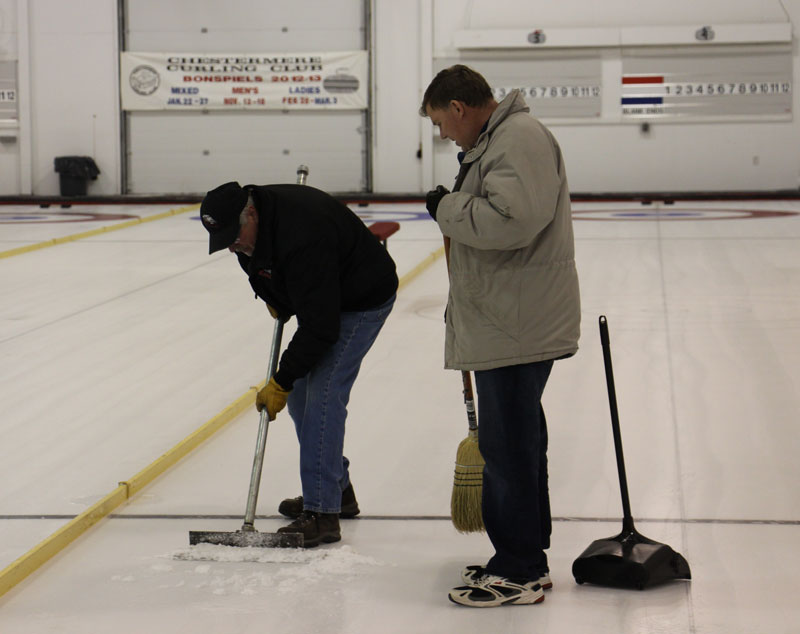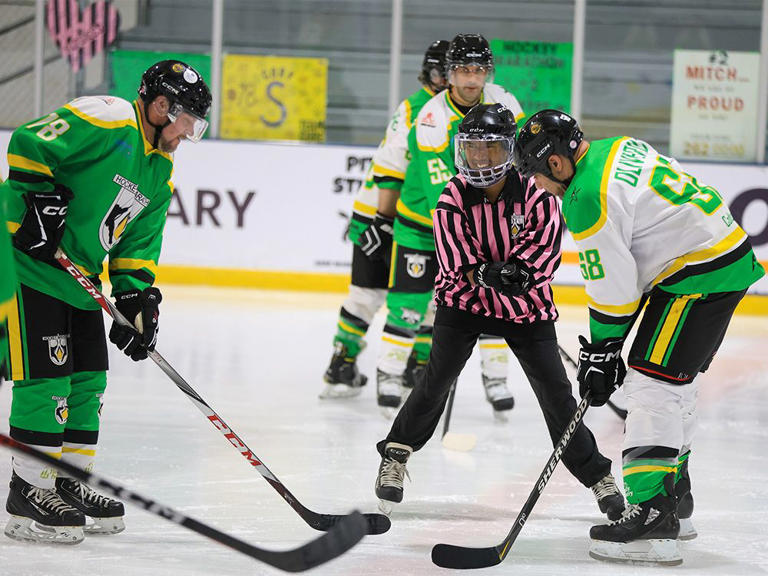
CHESTERMERE – There are a number of jobs that people do for a living that many people take for granted; also many that don’t get recognized as an important service. The Chestermere Recreation Centre employs several dedicated people who fit into both of these categories. You will see them around the building often busy going from rink to rink to rink and then somewhere else hoping to keep on top of the many tasks that are required of them on a daily basis.
The regular curling season takes a break over the Christmas holidays and this allows the rink staff to do a little maintenance on the curling rinks and recondition the ice surface midway through the season. This is a task that is undertaken every year at this time as the rink is so busy this really is their only chance to do the work. As a curler myself I am one of those people who never considered how the rink staff needs to be so meticulous in the way they make, prepare and maintain the ice surface for us curlers.
Initially the ice is prepared sometime in late September as the curling season starts in the early part of October and takes the better part of a week to get the ice surfaces in place. As mentioned earlier, many people don’t know the intricacies of some of the jobs out there and therefore don’t appreciate the hard work and complexity of making curling ice.
First consideration is of course there must be a network of piping below the entire surface of the floor. Perfectly chilled water is pumped thorough the pipes making the floor cold enough to freeze the water which will be discharged across the floor. As you may not know, there is yet another set of pipes below the chilled pipes that have a hot water in them and is also covers the entire subsurface of the floor. The warm piping system keeps the ground beneath the floor from continually freezing. If the cold was allowed to continually penetrate the ground below, the floor would heave from the frost. The temperature of the two piping systems must be constantly monitored in order to avoid some expensive repairs should one of the systems fail.
The preliminary work begins as the concrete floor is scrubbed and cleaned like a hospital hallway. If there is dirt or other material not cleaned up it will surely become part of the ice and could cause some major headaches for the curlers. It is now time to begin with a flooding of the floor. This first flood will be small and raise the ice level an inch or two. The water temperature and the amount of water used is carefully monitored. The water used for the ice goes through a special brine canister similar to a soft water conditioner that removes minerals and “softens” the water (deionized water). Once the first level of ice has frozen, a coat of special water based paint is mixed and sprayed over the entire ice surface until it is all completely white. The painted ice is then sealed with water a minimum 12 times while once again constantly monitoring the ice temperature during this process. The ice warms up after each application so it is important to wait until the ice cools to the original temperature before applying the next coat. As you can imagine this is a tedious task.
Next is the layout of the rinks. Each rink is carefully measured in every direction for the hack, the centre line, hog lines etc. Regular knitting wool is stretched between prescribed points, tied off and then stuck to the ice surface with a fine spray of water. Who knew knitting wool could be so versatile. Once each sheet is marked out and the hacks installed, then it’s time to lay out the side rails for each sheet. Following that, the house circles are cut into the ice surface so they can be painted blue and red. With all that preparation and painstaking measuring done the rink sheets will be flooded numerous times getting a good even layer of ice on each sheet.
If you thought the more precise work had already been completed, you’d be wrong, for now it is time for the pebbling and nipping the ice surface. Tiny droplets of water are applied several times with a hand held sprinkling device over each sheet; this is called pebbling. A special machine with a sharp blade goes up and down each sheet several times which cuts or “Nips” off the tops of the tiny ice beads. It shaves the ice so to speak. This process could be done as many as 12 to 15 times before each sheet of ice is completely level. The key to making the curling rocks “curl” around other rocks and into the house is pebbling and nipping and is one of the most important techniques in ice preparation and ongoing maintenance. The ice is now ready for the curlers to begin the season but there is still so much maintenance and ice preparation that needs to be undertaken between each game.
This is but one aspect of what the CRCA maintenance workers do. To think that they have 2 more ice rinks to flood and prepare for pleasure skating and hockey, clean the change rooms, janitorial services throughout the building and setting up tables and chairs for other functions in the main gym and MPP rooms; these guys are busy – busy.
So whether or not you’re a curler, a skater, hockey player or just find it interesting to read about the people in your community, it’s good to know how hard some people work to make your stay at the Rec. Centre enjoyable and memorable.






